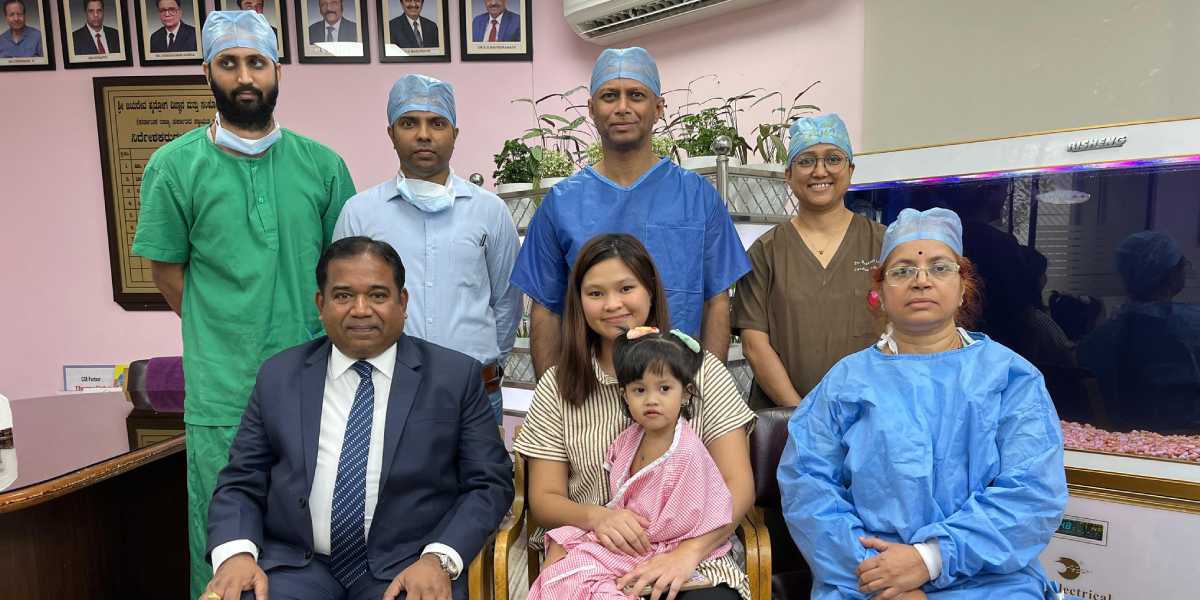Congenital heart defects occur in roughly one of every 100 births worldwide. Many require surgical intervention to survive past childhood.
Published Nov 28, 2025 | 4:33 PM ⚊ Updated Nov 28, 2025 | 4:33 PM

Aviannalyn Jade Amoroso Rey with the surgeons.
Synopsis: Aviannalyn’s journey began at the Philippines Heart Centre, where cardiologists detected Tetralogy of Fallot. Her lips sported a bluish tint. She breathed in short gasps. When she tried to play, fatigue overtook her within minutes. Her oxygen saturation dropped to 75 percent, a level at which most adults would struggle to remain conscious.
The operating theatre at Bengaluru’s Sri Jayadeva Institute of Cardiovascular Sciences and Research was silent as surgeons leaned over a chest cavity no bigger than an adult’s palm.
Inside, a two-year-old heart was beating with four separate defects. Aviannalyn Jade Amoroso Rey from the Philippines was on the operating table. The next few hours would decide if she would go home alive.
Aviannalyn’s journey began at the Philippines Heart Centre, where cardiologists detected Tetralogy of Fallot. Her lips sported a bluish tint. She breathed in short gasps. When she tried to play, fatigue overtook her within minutes. Her oxygen saturation dropped to 75 percent, a level at which most adults would struggle to remain conscious.
“Tetralogy of the Fallot is quite a common congenital heart defect, with symptoms of cyanosis,” Dr PK Sunil, Professor of Cardiothoracic Surgery at SJICR, told South First. “It can affect anyone. This patient was from the Philippines, and Rotary International sponsored the surgery.”
The Philippines Heart Centre had referred her to India. Rotary Bengaluru Midtown and the Rotary Needy Heart Foundation sponsored the surgery, and also met the travel and medical expenses.
Jayadeva Hospital is one of the largest single cardiac speciality centres in South East Asia. “The facility has more than a thousand beds. Since it’s a government institute, it offers procedures at a subsidised cost,” Dr Sunil said.
The surgical unit handles 10 to 12 international cases each year, treating patients from Nepal, Bangladesh, Myanmar, and island nations across the Indian Ocean.
Aviannalyn had checked in on 1 November. Doctors conducted echocardiograms that mapped her heart’s structure, blood work that assessed her clotting factors, and imaging that showed how her lungs had adapted to chronic oxygen deprivation.
“She had four aspects that required surgical correction,” Dr Sunil explained.
Tetralogy of Fallot traps the heart in four ways: thick muscle blocks the right ventricle, a hole punctures the wall between pumping chambers, the aorta sits displaced, and the pulmonary valve narrows. Blood that should reach the lungs for oxygen gets pumped straight back to the body.
The surgical team performed a TOF Repair, stopping the heart and connecting Aviannalyn to a bypass machine.
First, surgeons patched the hole between the ventricles. Then, they cut away obstructive muscle tissue. Finally, reconstruction reshaped the right atrial appendage.
Throughout, anaesthesiologists monitored vital signs while perfusionists managed the bypass machine.
“This surgery must be done anywhere between six months to two years, depending on the severity of the symptoms,” Dr Sunil said.
Wait too long, and the damage becomes permanent. Blood vessels in the lungs develop pressures that cannot be reversed. The heart muscle thickens beyond repair. Brain development suffers. Operate too early, and the heart remains too small. Tissue tears. Patches fail.
“The risks of the surgery involve possibilities of low cardiac output, arrhythmias, and even death,” Dr Sunil stated.
“The patient we operated on is doing well,” Dr Sunil said days after the procedure.
The heart has been beating steadily. The oxygen saturation has climbed above 95 percent. The bluish tint has faded from her lips and fingernails. Her parents, who travelled across international borders and navigated a foreign medical system, saw their daughter breathe without struggle for the first time.
According to Dr B Dinesha, Director of Jayadeva Institute, the surgery has given Aviannalyn what doctors call “a new lease on life.”
Congenital heart defects occur in roughly one of every 100 births worldwide. Many require surgical intervention to survive past childhood. In countries with limited cardiac care infrastructure, these children often die before reaching their fifth birthday.
Two-Year-Old Philippine Child Receives New Lease on Life at Bengaluru’s Jayadeva Hospital
Bengaluru
A two-year-old child from the #Philippines, Aviannalyn Jade Amoroso Rey, has been given a new chance at life after successfully undergoing complex open-heart surgery at the Sri… pic.twitter.com/J1SANldGOJ
— Yasir Mushtaq (@path2shah) November 26, 2025
